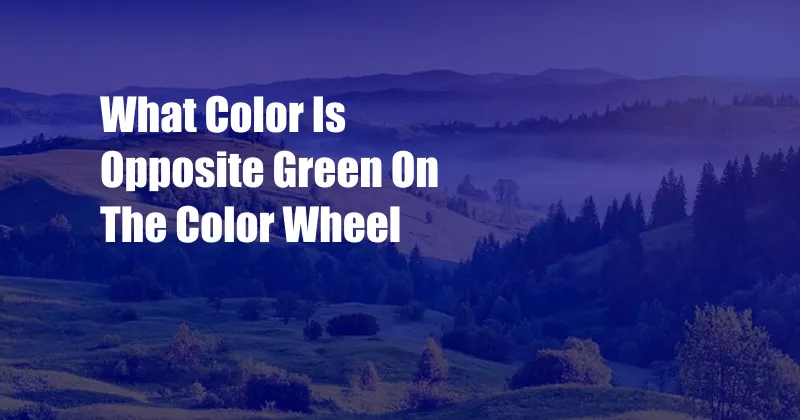
What Color is Opposite Green on the Color Wheel?
The color wheel is a powerful tool for understanding color theory and creating harmonious color combinations. When artists and designers refer to the color wheel, they are typically referring to the traditional RYB color wheel, which stands for red, yellow, and blue. On the RYB color wheel, the color opposite green is red. This is because red and green are complementary colors, meaning they are directly opposite each other on the color wheel and create a high contrast when placed side by side.
The complementary color relationship is one of the most important concepts in color theory. Complementary colors create a sense of visual tension and excitement, and they can be used to draw attention to certain elements of a design. For example, a red headline on a green background will immediately capture the reader’s attention. Complementary colors can also be used to create a sense of balance and harmony in a design. By using equal amounts of complementary colors, you can create a scheme that is both visually appealing and calming.
The History of the Color Wheel
The color wheel was first developed by Sir Isaac Newton in the 17th century. Newton was studying the nature of light and color, and he discovered that white light can be separated into a spectrum of colors by passing it through a prism. Newton arranged the colors of the spectrum in a circle, creating the first color wheel.
Since Newton’s time, the color wheel has been refined and modified by many different artists and scientists. The RYB color wheel is still widely used today, but there are also other color wheels that use different color models, such as the CMYK color wheel (used in printing) and the HSV color wheel (used in digital design).
The Meaning of Green
Green is the color of nature, growth, and renewal. It is a calming and refreshing color that can be used to create a sense of peace and tranquility. Green is also associated with money, luck, and fertility. In many cultures, green is seen as a sacred color, and it is often used in religious ceremonies and rituals.
The Meaning of Red
Red is the color of passion, love, and danger. It is a stimulating and exciting color that can be used to draw attention to important elements of a design. Red is also associated with anger, violence, and war. In some cultures, red is seen as a lucky color, while in other cultures it is seen as a symbol of mourning.
The Complementary Color Relationship
The complementary color relationship is one of the most important concepts in color theory. Complementary colors are colors that are directly opposite each other on the color wheel. When placed side by side, complementary colors create a high contrast and visual tension. This contrast can be used to draw attention to certain elements of a design or to create a sense of balance and harmony.
Red and green are complementary colors. When placed side by side, they create a high contrast that is both visually appealing and exciting. This contrast can be used to draw attention to important elements of a design, such as a headline or a call to action button. Red and green can also be used to create a sense of balance and harmony in a design. By using equal amounts of red and green, you can create a scheme that is both visually appealing and calming.
Tips for Using Complementary Colors
Here are a few tips for using complementary colors in your designs:
- Use complementary colors in moderation. Too much contrast can be overwhelming and distracting.
- Place complementary colors close together. This will create a stronger contrast and visual tension.
- Use complementary colors to create a focal point. By placing a complementary color on a neutral background, you can draw attention to that element.
- Use complementary colors to create a sense of balance. By using equal amounts of complementary colors, you can create a scheme that is both visually appealing and calming.
Expert Advice on Using Complementary Colors
Here is some expert advice on using complementary colors in your designs:
“Complementary colors are a powerful tool for creating contrast and excitement in your designs. Use them wisely and you can create stunning visuals that will captivate your audience.” – Canva Design Team
“When using complementary colors, it is important to find the right balance. Too much contrast can be overwhelming, while too little contrast can be boring. Experiment with different combinations until you find the perfect balance for your design.” – Adobe Color Team
FAQ on Complementary Colors
Here are some frequently asked questions about complementary colors:
- What are complementary colors? Complementary colors are colors that are directly opposite each other on the color wheel.
- What is the complementary color of green? The complementary color of green is red.
- How can I use complementary colors in my designs? Complementary colors can be used to create contrast, excitement, and balance in your designs.
- What are some tips for using complementary colors? Here are some tips for using complementary colors:
- Use complementary colors in moderation.
- Place complementary colors close together.
- Use complementary colors to create a focal point.
- Use complementary colors to create a sense of balance.
Conclusion
Complementary colors are a powerful tool for creating contrast, excitement, and balance in your designs. By understanding the complementary color relationship, you can use complementary colors to create stunning visuals that will captivate your audience. So, what are you waiting for? Start using complementary colors in your designs today!
Are you interested in learning more about color theory? Check out our other blog posts on the topic: